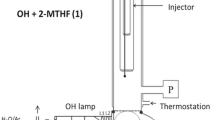Abstract
The combustion characteristics and detonability of propargyl bromide, propargyl chloride, and allene were investigated as a means to evaluate their hazard in storage, use, and transportation. All three will undergo monopropellant burning, but their ignitibility and tendency toward monopropellant burning were reduced by dilution with toluene.
Similar content being viewed by others
References
Cummings, G. A., McD., Hall, A. R., and Straker, R. A. M., “Decomposition Flames of Acetylene and Methylacetylene,”Eighth Symposium (International) on Combustion, (Williams and Wilkins Co., Baltimore, 1962), p. 503.
Jones, G. W., Kennedy, R. E., and Spolan, I., “Effect of Hydrocarbons and Other Gases Upon the Explosibility of Acetylene,” R.I. 4196, 1948, U.S. Bureau of Mines, 8 pp.
Kuchta, J. M., Spolan, I., and Zabetakis, M. G., “Flammability Characteristics of Methylacetylene, Propadiene (Allene), and Propylene Mixtures,”Journal of Chemical and Engineering Chemistry Data, Vol. 9, No. 3 (1964), pp. 467–472.
Scott, G. S., Kennedy, R. E., Spolan, I., and Zabetakis, M. G., “Flammability Characteristics of Ethylene,” R. I. 6659, 1965, U. S. Bureau of Mines, 10 pp.
Coffee, R. D., and Wheeler, J. J., “The Explosibility and Stabilization of Propargyl Bromide,” Safety and Loss Prevention Symposium, AIChE Meeting, Houston, Texas, Feb. 20–22, 1967, 19 pp.
Mason, C. M., Van Dolah, R. W., and Weiss, M. L., “Drop-Weight Testing of Explosive Liquids,” R.I. 6799, U. S. Bureau of Mines, 1966, 15 pp.
Chemical Propulsion Information Agency, Applied Physics Laboratory, Johns Hopkins University, Test No. 4, “Drop-Weight Test,” Joint Army-Navy-Air Force Panel on Liquid Propellant Test Methods, Silver Spring, Md., May 1964, 18 pp.
Princeton University Statistical Research Group, “Statistical Analysis of a New Procedure in Sensitivity Experiments,” AMP Report 101.1R, SRG-P 40, July 1944, 58 pp. (Available in microfilm and camera copy from the Library of Congress under Order No. PB23709.)
Chemical Propulsion Information Agency, Applied Physics Laboratory, Johns Hopkins University, Test No. 1, “Card Gap Test for Shock Sensitivity of Liquid Monopropellants,” Joint Army-Navy-Air Force Panel on Liquid Propellant Test Methods, Silver Spring, Md., 1960, 24 pp.
Steinberger, R., “Mechanism of Burning of Nitrate Esters,”Fifth Symposium (International) on Combustion, (Reinhold Publishing Corp., New York, 1955), p. 205.
Steinberger, R. and Carder, R. E., “Surface Temperature of Burning Liquid Nitrate Esters,”Journal of Physics and Chemistry, Vol. 59 (1955), p. 255.
Steinberger, R., Orlick, C. A., and Schaaf, V. P., “Burning Rates of Deuterated Nitrate Esters,”Journal of the American Chemical Society, Vol. 77 (1955), p. 4748.
Tait, C. W., Whittaker, A. G., and Williams, H., “Measurement of the Burning Rate of Liquid Propellants,”Journal of the American Rocket Society, Vol. 85 (1951), p. 83.
Whittaker, A. G., Williams, H., Rust, P. M., and Skolnik, S., “Burning Rate Studies,” NAVORD Report 1999, Part 1, 1952, 23 pp.
Sargent, H. B., “How to Design a Hazard-Free System to Handle Acetylene,”Chemical Engineering, No. 64 (Feb. 1957), p. 250.
Paillard, C., Moreau, R., Combourieu, J., and Laffitte, P., “Caractères Généraux de la Flame de Décomposition de L'Azoture de Chlore” (The General Characteristics of the Decomposition Flame of Chloro Nitride), Compt. Rend. (Paris), Vol. 264, Series C (1967), p. 382.
Scott, F. E., Burns, J. J., and Lewis, B., “Explosive Properties of Hydrazine,” R.I. 4460, U.S. Bureau of Mines, 1949, 18 pp.
Hicks, J. A., “The Low-Pressure Decomposition Flame of Ethyl Nitrate,”Eighth Symposium (International) on Combustion (Williams and Wilkins Co., Baltimore, 1962), p. 487.
Author information
Authors and Affiliations
Rights and permissions
About this article
Cite this article
Forshey, D.R., Cooper, J.C., Martindill, G.H. et al. Potential hazards of propargyl halides and allene. Fire Technol 5, 100–111 (1969). https://doi.org/10.1007/BF02591588
Issue Date:
DOI: https://doi.org/10.1007/BF02591588




